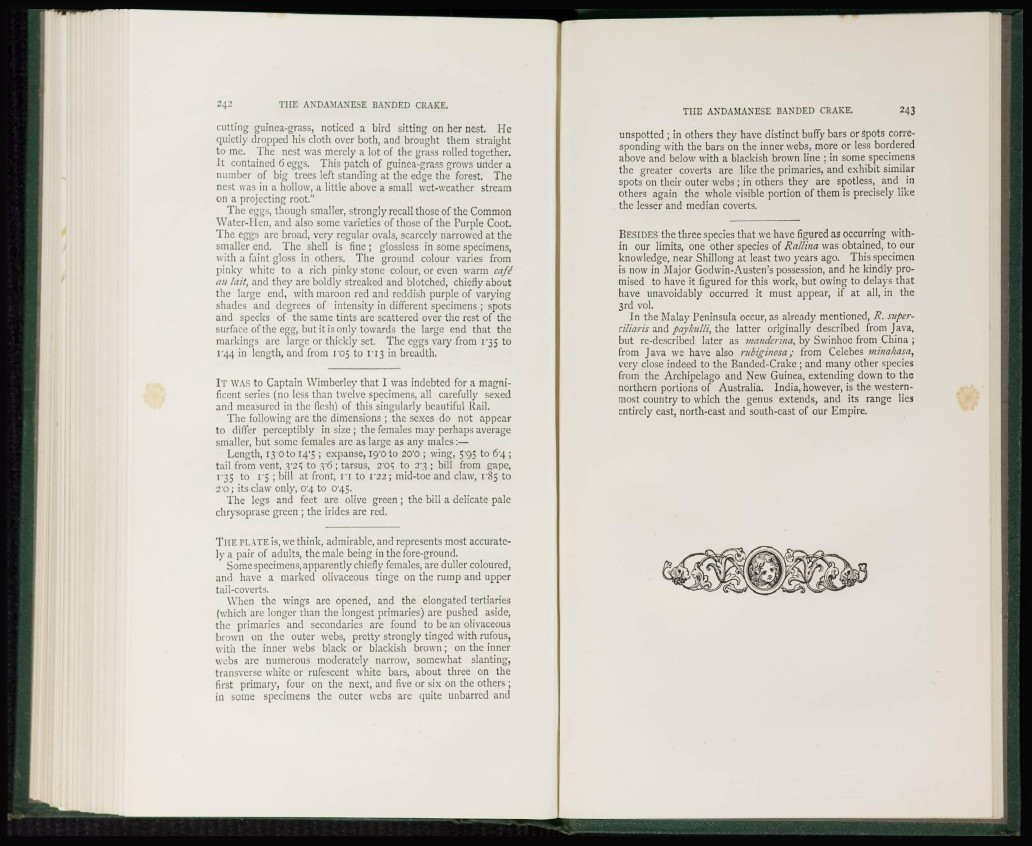
242 THE ANDAMANESE BANDED CRAKE.
cutting guinea-grass, noticed a bird sitting on her nest. He
quietly dropped his cloth over both, and brought them straight
to me. The nest was merely a lot of the grass rolled together.
It contained 6 eggs. This patch of guinea-grass grows under a
number of big trees left standing at the edge the forest. The
nest was in a hollow, a little above a small wet-weather stream
on a projecting root."
The eggs, though smaller, strongly recall those of the Common
Water-Hen, and also some varieties of those of the Purple Coot.
The eggs are broad, very regular ovals, scarcely narrowed at the
smaller end. The shell is fine ; glossless in some specimens,
with a faint gloss in others. The ground colour varies from
pinky white to a rich pinky stone colour, or even warm café
au lait, and they are boldly streaked and blotched, chiefly about
the large end, with maroon red and reddish purple of varying
shades and degrees of intensity in different specimens ; spots
and specks of the same tints are scattered over the rest of the
surface of the egg, but it is only towards the large end that the
markings are large or thickly set. The eggs vary from 1-35 to
144 in length, and from f05 to f 13 in breadth.
I T WAS to Captain Wimberley that I was indebted for a magnificent
scries (no less than twelve specimens, all carefully sexed
and measured in the flesh) of this singularly beautiful Rail.
The following are the dimensions ; the sexes do not appear
to differ perceptibly in size ; the females may perhaps average
smaller, but some females are as large as any males:—
Length, 13'OTO 14*5 ; expanse, 19/0 to 20*o ; wing, 5*95 TO 64 ;
tail from vent, 3'25 to 3'6 ; tarsus, 2'05 to 2'3 ; bill from gape,
1-35 to 15 ; bill at front, r i TO V22; mid-toe and claw, 185 TO
2-o; its claw only, 04 to 045.
The legs and feet are olive green ; the bill a delicate pale
chrysoprase green ; the irides are red.
THE N . A T E is, we think, admirable, and represents most accurately
a pair of adults, the male being in the fore-ground.
Some specimens, apparently chiefly females, are duller coloured,
and have a marked olivaceous tinge on the rump and upper
tail-coverts.
When the wings are opened, and the elongated tertiaries
(which are longer than the longest primaries) are pushed aside,
the primaries and secondaries are found to be an olivaceous
brown on the outer webs, pretty strongly tinged with rufous,
with the inner webs black or blackish brown ; on the inner
webs are numerous moderately narrow, somewhat slanting,
transverse white or rufescent white bars, about three on the
first primary, four on the next, and five or six on the others ;
in some specimens the outer webs are quite unbarred and
THE ANDAMANESE BANDED CRAKE. 243
unspotted ; in others they have distinct buffy bars or spots corresponding
with the bars on the inner webs, more or less bordered
above and below with a blackish brown line ; in some specimens
the greater coverts are like the primaries, and exhibit similar
spots on their outer webs ; in others they are spotless, and in
others again the whole visible portion of them is precisely like
the lesser and median coverts.
BESIDES the three species that we have figured as occurring within
our limits, one other species of Rallina was obtained, to our
knowledge, near Shillong at least two years ago. This specimen
is now in Major Godwin-Austen's possession, and he kindly promised
to have it figured for this work, but owing to delays that
have unavoidably occurred it must appear, if at all, in the
3rd vol.
In the Malay Peninsula occur, as already mentioned, -/?. superciliaris
and paykulli, the latter originally described from Java,
but re-described later as manderina, by Swinhoe from China ;
from Java we have also rubiginosa; from Celebes minahasa,
very close indeed to the Banded-Crake ; and many other species
from the Archipelago and New Guinea, extending down to the
northern portions of Australia. India, however, is the westernmost
country to which the genus extends, and its range LIE3
entirely east, north-east and south-cast of our Empire.